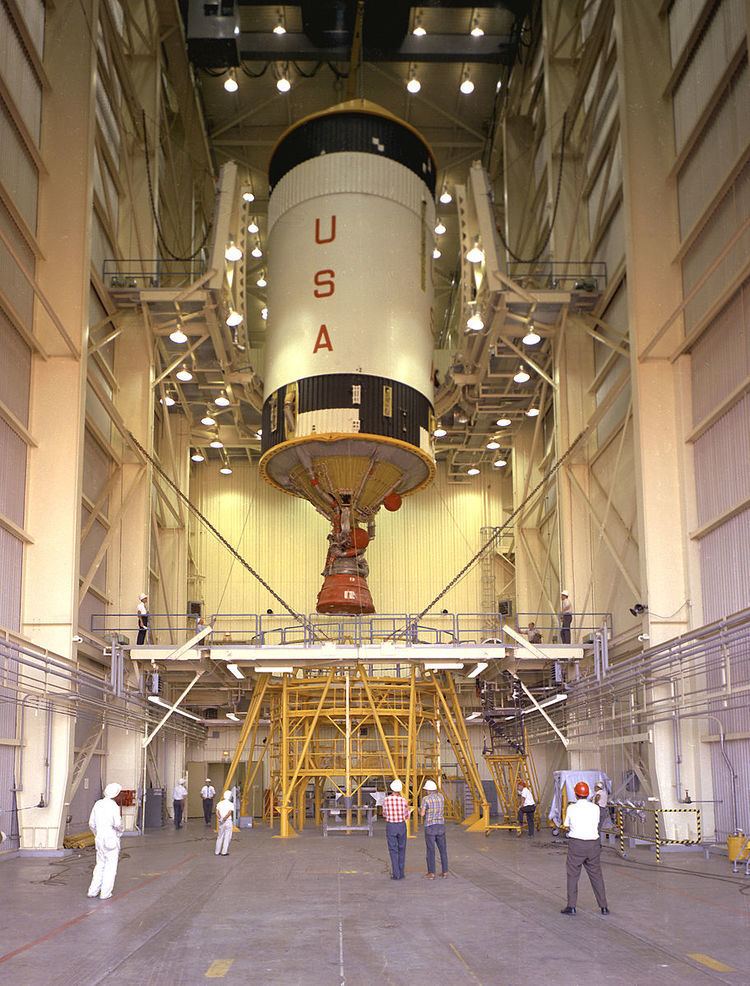Country of origin USA | ||
 | ||
Height 58 feet 5 inches (17.81 m) Diameter 21 feet 8 inches (6.60 m) Gross mass 253,000 pounds (115,000 kg) | ||
The S-IVB (sometimes S4b, always pronounced "ess four bee") was built by the Douglas Aircraft Company and served as the third stage on the Saturn V and second stage on the Saturn IB. It had one J-2 engine. For lunar missions it was fired twice: first for the orbit insertion after second stage cutoff, and then for translunar injection (TLI).
Contents
History
The S-IVB evolved from the upper stage of the Saturn I rocket, the S-IV, and was the first stage of the Saturn V to be designed. The S-IV used a cluster of six engines but used the same fuels as the S-IVB — liquid hydrogen and liquid oxygen. It was also originally meant to be the fourth stage of a planned rocket called the C-4, hence the name S-IV.
Eleven companies submitted proposals for being the lead contractor on the stage by the deadline of 29 February 1960. NASA administrator T. Keith Glennan decided on 19 April that Douglas Aircraft Company would be awarded the contract. Convair had come a close second but Glennan did not want to monopolize the liquid hydrogen-fueled rocket market as Convair was already building the Centaur rocket stage.
In the end the Marshall Space Flight Center decided to use the C-5 rocket (later called the Saturn V), which had three stages and would be topped with an uprated S-IV called the S-IVB which instead of using a cluster of engines would have a single J-2 engine. Douglas was awarded the contract for the S-IVB because of the similarities between it and the S-IV. At the same time it was decided to create the C-IB rocket (Saturn IB) that would also use the S-IVB as its second stage and could be used for testing the Apollo (spacecraft) in Earth orbit.
Configuration
Douglas built two distinct versions of the S-IVB, the 200 series and the 500 series. The 200 series was used by the Saturn IB and differed from the 500 in the fact that it did not have a flared interstage and had less helium pressurization on board as it would not be restarted. On the 500 series, the interstage needed to flare out to match the larger diameter of the S-IC and S-II stages of the Saturn V. The 200 series also had three solid rockets for separating the S-IVB stage from the S-IB stage during launch. On the 500 series this was reduced to two, and two small APS (auxiliary propulsion system) thruster modules were added as ullage motors for restarting the J-2 engine and to provide attitude control during coast phases of flight.
The S-IVB carried 73,280 liters (19,359 U.S. gallons) of LOX, massing 87,200 kg (192,243 lbs). It carried 252,750 liters (66,770 U.S. gallons) of LH2, massing 18,000 kg (39,683 lbs). Empty mass was 10,000 kg (23,000 lb)
Attitude control was provided by J-2 engine gimballing during powered flight and by the two APS modules during coast. The APS modules each contained four thrusters providing 150 pounds of thrust (three for roll, pitch, and yaw; one for ullage) and were fueled by a hypergolic mixture of dinitrogen tetroxide and monomethyl hydrazine. They were used for three-axis control during coast phases, roll control during J-2 firings, and ullage for the second ignition of the J-2 engine and deorbit into the moon.
A surplus S-IVB tank, serial number 212, was converted into the hull for Skylab, the United States' first space station. Skylab was launched on a Saturn V on May 14, 1973, and re-entered the atmosphere on July 11, 1979. A second S-IVB, serial number 515, was also converted into a backup Skylab, which never flew.
During Apollo 13, Apollo 14, Apollo 15, Apollo 16 and Apollo 17, the S-IVB stages were crashed into the Moon to perform seismic measurements used for characterizing the lunar interior.
Stages built
(* See List of artificial objects on the Moon for location.)
Future
The second stage of the Ares I rocket and the proposed Earth Departure Stage (EDS) would have had some of the characteristics of the S-IVB stage, as both would have had an uprated J-2 engine, called the J-2X, with the latter performing the same functions as that of the Series 500 version of the stage (placing the payload into orbit, and later firing the spacecraft into trans-lunar space).
